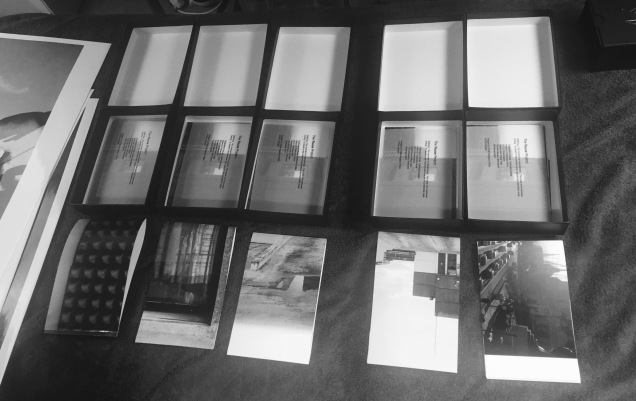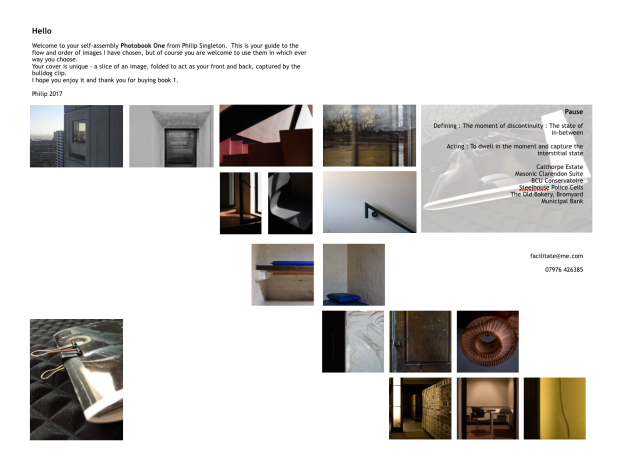MA in Photography, Falmouth University, Module 3, Surfaces and Strategies
Figure 1
Format
This module has encouraged us to talk to people who publish photobooks, take a closer look at photobooks we own and read about the business of editing, crafting and publishing into this popular medium (or surface) to exemplify practice.
My practice is not about Henri Cartier-Bresson’s ‘decisive moment’ it is instead a negotiated reveal of spaces that are otherwise unseen, the work is a carefully considered insight into the intimacy of surfaces and spaces and thus I presently feel that in the long term the collected works would suit a photobook form as a form of documentary memory of change in a city. This decision led me to consider the image making and editing process in the current work in progress portfolio. In some instances I have not shot using a square frame in situ, rather I have created a square frame within the shot frame, in other words I frame on site and frame again in the post production phase. I was satisfied with the outcome of this proposal as the ‘desktop’ review facilitated a greater degree of focus and determined editing. As I anticipate a square sheet page layout in an ultimate book I believe it advantageous to the visual framing to adopt a substantial ‘white’ border around each image; this is reflected in the work in progress submission, figure 1.
The Four Projects
As I reminder, my Pause practice is about defining : the moment of discontinuity : the state of in-between. My work in situ is about acting : to dwell in the moment and capture the interstitial state.
The images capture a reflective, meditative, intimate view of Birmingham’s buildings that are in a pause state, life has left them, they await death by demolition or new breath through new use. Often the marks and scars of use are recorded on walls and surfaces, but human life has departed. One set of images are of a project in Birmingham’s rural hinterland being revived and redimensioned by a Birmingham based architect; the Bake House is silent and disused.
The body of work is growing as each building at risk is accessed through careful negotiation and recorded as a memory to be shared. I see this as an important gathering of memories as Birmingham (which I regard as my city) embarks on the pains of massive regeneration.
A Commentary : there are 4 buildings represented in the portfolio;
The Bake House is in Bromyard on the fringes of Herefordshire. It has lain unused as a bakery, retail shop and home for a long time. Its domestic scale, quirks, such as a cupboard within a wall, faded colours and fittings convey a maker space and a home; handles, cistern chains, shelves and paper bags are suspended, the left-overs from the last days yeasty smells and conversations. The opening image holds a key in place adjacent to a smudged out window, views without and within hinted at but not revealed, like a sleepy eye.
This building was chosen for its domestic character (relative to my other projects) and it is the first project to manifest from a new ‘artist in residence’ agreement I have reached with K4 Architects which is based in Birmingham. It is expected that this residency will provide me with a rich seam of subjects toward my MA major project.
The Steelhouse Police Cells are on the fringe of the central business district in Birmingham. I had heard the West Midlands Police were planing to vacate as part of its property efficiency programme. It is just entering the pause state. The Victorian building is substantial and a side door leads from the street down into the basement cells, used to detain people arrested before the first trial stages or release. Despite an appearance of apparent cleanliness, such as repeated layering of paint on cell walls, attempts to cover history have not succeeded. It was a hurried shoot with little access time and it was upon download and reflection that I saw the marks on walls emerging through paints and dirty corners – the places where detainees would stare for hours at a time. The edit was radical in this series as I had captured the familiar Victorian architectural flourishes extensively, but this seemed to me to be less relevant to the story of the actual cells. The three images are intended to capture the bland, claustrophobic nature of existence.
Icknield Port Loop is an emerging body of work. It is also a departure for my practice as I am dealing with looking in from beyond fences and walls towards a large scale regeneration project that has been years in waiting. The work is a little less intimate and demands a more overt voyueristic approach. The three chosen images are all about conveying closure, protection and security. The ambition is to create an open and inclusive community; these images say there is a long way to go. I anticipate this project expanding over time. I have been visiting early on sunday mornings to gather these images.
The Municipal Bank is, like the Police cells, protected by listing. If it were not it would have been removed already as it finds itself enveloped by new neighbours 4 or 5 times its volume. It is a classical form and has been in its pause state for many years. It is a hollow building with the exception of the rather richly coloured and detailed vault containing hundreds of deposit boxes that each contained a drawer for small, precious items belonging to the bank’s customers. Again I was in a basement; I chose to work with the found light as the quality of reflection from each open door was striking. I was advised that Chanel had booked the space recently for an ad’ shoot. The most poignant image is looking through the doorway into an office with the deposit box perched on the desk, suggesting an interaction that was the last.


































